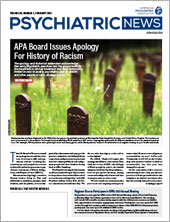"I want to die with dignity."
Those were the words of a 40-year-old man with metastatic adenocarcinoma of the colon who requested physician-assisted death under California’s End of Life Option Act (EOLA). He had been started on palliative radiation while having persistent distress related to lower GI bleeding, pain, and poor quality of life. He was determined to have less than six months to live, as required by the law to request aid in dying.
Individual institutions in the state have their own required protocols under EOLA, and Stanford Medical Center—where he was a patient—required him to initiate the request for aid in dying with an oncologist and separately with a palliative medicine physician. Their evaluation revealed a history of a depressive episode prior to the cancer diagnosis with a suicide attempt and psychiatric hospitalization.
This history prompted an evaluation by a psychiatrist, as required by the Stanford protocol, which revealed the patient had sought psychiatric treatment after hospitalization that resulted in remission of his depression and suicidal ideation. During the psychiatric evaluation for assisted death under EOLA, there was no evidence of any psychiatric disorder or acute mood symptoms, and he demonstrated the capacity to proceed.
The case illustrates the ethical and legal issues confronting institutions and physicians in states that have legalized physician-assisted death (PAD). That includes psychiatrists who treat patients with cancer and other terminal illness or who are called upon to assess the decision-making capacity of patients who request aid in dying. Today, seven other states and the District of Columbia have adopted laws allowing PAD.
Sheila Lahijani, M.D., a psycho-oncologist and clinical associate professor of psychiatry and behavioral sciences at Stanford University, outlined those challenges in a workshop at the virtual meeting of the Academy of Consultation-Liaison Psychiatry.
It is one of the most contested issues in modern American medicine, with disagreement even about the terms that are employed (see box). At the same time, meeting patient needs for end-of-life care has also grown to be one of the most urgent issues in medicine. Lahijani in her remarks cited Atul Gawande in his 2014 bestselling book Being Mortal: Medicine and What Matters in the End: “People with serious illness have priorities beyond simply prolonging their lives. ... Our system of technological care has utterly failed to meet these needs, and the cost of this failure is measured in far more than dollars. The question therefore is … how we can build a health care system that will actually help people achieve what’s most important to them at the end of their lives.”
The requirements of PAD laws are broadly similar across states in which it is legal. Lahijani said California’s law requires the patient to be 18 or over, have a terminal illness expected to result in death within six months, be assessed for medical decision-making capacity and determined to be free of impaired judgment secondary to a mental illness, and have the physical and mental ability to self-administer the medication. The patient cannot request aid in dying in an advance directive or other document, and no other individual or surrogate decision maker can request aid in dying. The patient must make two requests orally and one in writing.
“The role of the psychiatrist is to serve as the mental health specialist,” Lahijani said. “While it is not a required consultation under California law, it may be requested and may be required by the particular institution. The psychiatrist does not diagnose the illness as terminal or prescribe any medication.”
•
The duties of the psychiatrist include the following:
•
Evaluate the individual and his/ her relevant medical records.
•
Determine that the individual has medical decision-making capacity, can act voluntarily, and can make an informed decision.
•
Determine that the individual does not have impaired judgment secondary to a mental illness.
•
Document the outcome and determinations made during the assessment.
Lahijani cited a California state report from 2018 that showed that 337 individuals had died that year under the state’s EOLA. The median age was 74; most patients were White (88.4%) and female (51%). A total of 88.1% were receiving hospice or palliative care, and 68.8% had a cancer diagnosis.
A 2013 report in the New England Journal of Medicine on the experience of one comprehensive cancer care center in Oregon found that the three most common reasons that patients request aid in dying were loss of autonomy, inability to engage in enjoyable activities, and loss of dignity.
“There are a number of discussion points for physicians and patients pursuing PAD,” Lahijani said. “These include how PAD may affect the patient and the possibility that death may not happen immediately. Additionally, it is important for alternatives to be discussed such as palliative care and pain control. The patient must be aware there is an option to withdraw the request and the option to not take the drug even if the prescription has already been filled.
“It is important for participating physicians to know they are protected by the law,” she said. “It is not mandatory for any physician to participate in [aid in dying]. Education and training about the process is necessary such that there is an understanding by health care professionals of what the qualifying criteria are and what the different institutional processes entail.” ■
“The APA Resource Document on Physician-Assisted Death” is posted
here.

